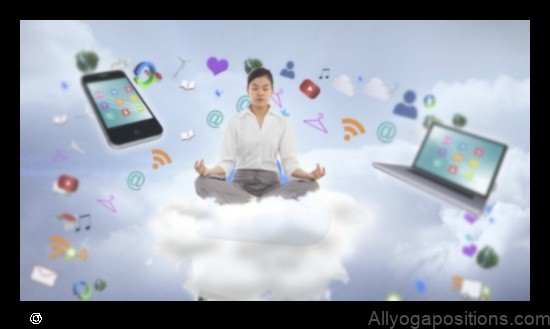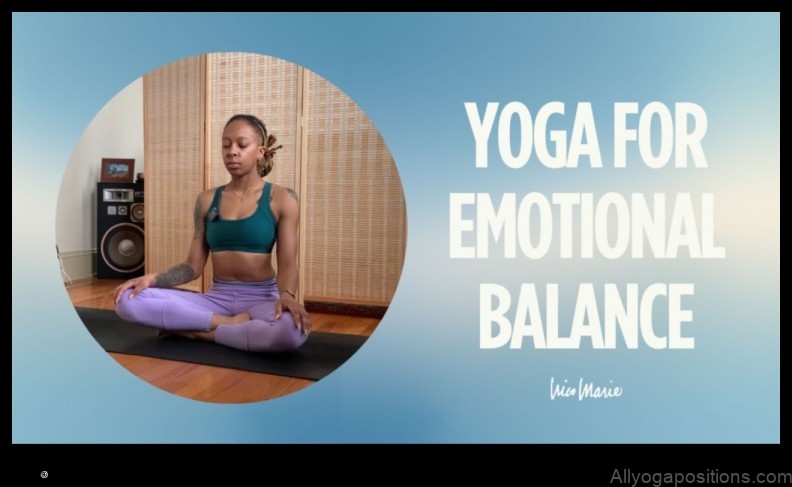
I. Introduction
Yoga and mindful technology use are two practices that can help to improve emotional balance. Yoga is a mind-body practice that combines physical postures, breathing exercises, and meditation. Mindful technology use is the practice of using technology in a way that is intentional and non-disruptive.
When practiced together, yoga and mindful technology use can help to reduce stress, improve focus, and promote a sense of well-being. In this article, we will discuss the benefits of yoga and mindful technology use, and how you can combine them to improve your emotional balance.

II. What is Yoga?
Yoga is a mind-body practice that originated in ancient India. It combines physical postures, breathing exercises, and meditation. Yoga is often practiced in a group setting, but it can also be done at home.
There are many different types of yoga, each with its own unique focus. Some of the most popular types of yoga include Hatha yoga, Vinyasa yoga, and Bikram yoga.
Yoga is a safe and effective way to improve your physical and mental health. It can help to reduce stress, improve flexibility, increase strength, and promote relaxation.
Benefits of Yoga for Emotional Balance
Yoga has been shown to have a number of benefits for emotional balance, including:
- Reduced stress
- Improved mood
- Increased self-awareness
- Improved sleep
- Reduced pain
III. How to Practice Yoga for Emotional Balance
If you are new to yoga, it is a good idea to start with a beginner class. This will help you to learn the basics of yoga and how to do the poses safely.
Once you have learned the basics, you can start to practice yoga at home. Here are a few tips for practicing yoga for emotional balance:
- Choose a time and place where you will be free from distractions.
- Wear comfortable clothing that you can move in easily.
- Start with a few simple poses and gradually increase the length of your practice as you feel comfortable.
- Listen to your body and stop if you feel pain.
- Make yoga a part of your regular routine.

IV. Mindful Technology Use
Mindful technology use is the practice of using technology in a way that is intentional and non-disruptive. This means using technology in a way that is mindful of your own needs and the needs of others.
There are a few things you can do to practice mindful technology use:
- Be aware of how you are using technology.
- Take breaks from technology throughout the day.
- Set limits on your screen time.
- Use technology for positive purposes.
Benefits of Mindful Technology Use
Mindful technology use has been shown to have a number of benefits, including:
- Reduced stress
- Improved focus
- Increased productivity
- Improved sleep
- Reduced anxiety
V. How to Practice Mindful Technology Use
Here are a few tips for practicing mindful technology use:
- Be aware of how you are using technology. Notice how you feel when you are using technology and how it affects your mood and productivity.
- Take breaks from technology throughout the day. Set a timer for yourself and get up and move around or do something else for a few minutes every hour or so.
- Set limits on your screen time. Decide how much time you want to spend on technology each day and stick to it.
Feature Description Emotional balance The ability to manage emotions in a healthy way Mindfulness The practice of paying attention to the present moment Technology use The use of technology in everyday life Yoga A mind-body practice that originated in ancient India Well-being A state of physical, mental, and social well-being II. What is Yoga?
Yoga is a mind-body practice that originated in ancient India. It involves a series of poses (asanas), breathing exercises (pranayama), and meditation.
Yoga is often said to have a number of benefits, including improving physical and mental health, reducing stress, and promoting relaxation.
In recent years, there has been growing interest in the use of yoga for emotional balance.
Research has shown that yoga can help to reduce anxiety, depression, and stress, and to improve mood and well-being.
Yoga can also help to increase mindfulness, which is the ability to pay attention to the present moment without judgment.
Mindfulness is a key skill for emotional balance, as it can help us to manage our emotions more effectively and to reduce stress.
Yoga is a safe and effective way to improve emotional balance.
It is a gentle practice that can be adapted to all levels of fitness.
Yoga can be practiced at home or in a studio.
If you are interested in learning more about yoga, there are many resources available online and in your local community.
III. Benefits of Yoga for Emotional Balance
Yoga has been shown to have a number of benefits for emotional balance, including:
- Reduced stress and anxiety
- Improved mood
- Increased self-awareness
- Enhanced relaxation
- Improved sleep
These benefits are due to the fact that yoga helps to regulate the body’s stress response, promote relaxation, and improve mindfulness.
IV. How to Practice Yoga for Emotional Balance
Yoga is a mind-body practice that can help to improve emotional balance in a number of ways.
It can help to reduce stress and anxiety. Yoga can help to reduce stress and anxiety by promoting relaxation and mindfulness. When you practice yoga, you focus on your breath and body movements, which can help to quiet your mind and reduce stress levels.
It can improve your mood. Yoga can improve your mood by increasing levels of serotonin and dopamine, two neurotransmitters that are associated with happiness and well-being.
It can help you to manage your emotions. Yoga can help you to manage your emotions by teaching you how to identify and process your emotions in a healthy way.
It can help you to connect with your body. Yoga can help you to connect with your body by increasing your awareness of your physical sensations and by helping you to move more mindfully.
It can help you to live in the present moment. Yoga can help you to live in the present moment by teaching you how to focus on your breath and body movements. This can help you to reduce stress and anxiety and to improve your overall sense of well-being.V. Mindful Technology Use
Mindful technology use is the practice of using technology in a way that is intentional and non-disruptive. It involves being aware of how you are using technology and how it is affecting your mental health.
When you use technology mindfully, you are more likely to:
- Be present in the moment
- Reduce stress
- Improve your mood
- Increase your productivity
Here are some tips for practicing mindful technology use:
- Set aside specific times each day for using technology.
- Turn off notifications on your phone and computer.
- Take breaks from using technology throughout the day.
- Be aware of how you feel when you are using technology and how it is affecting your mood.
Mindful technology use can help you to improve your emotional balance and well-being. By being intentional about how you use technology, you can reduce stress, improve your mood, and increase your productivity.
VI. Benefits of Mindful Technology Use
Mindful technology use can have a number of benefits for emotional balance, including:
- Reduced stress and anxiety
- Improved focus and attention
- Increased creativity and productivity
- Enhanced relationships
- Improved sleep
When we use technology mindfully, we are more aware of how it is affecting us and we are able to make choices that are in our best interests. We are less likely to be overwhelmed or addicted to technology, and we are more likely to use it in a way that supports our well-being.
Mindful technology use is a skill that can be learned and practiced. There are a number of resources available to help you get started, including books, articles, and online courses.
If you are interested in learning more about mindful technology use, I encourage you to check out the following resources:
VII. How to Practice Mindful Technology Use
Mindful technology use is about being aware of how you use technology and how it affects you. It means paying attention to the present moment, rather than getting caught up in the past or the future. It also means being aware of your thoughts and feelings about technology, and how they impact your behavior.
Here are some tips for practicing mindful technology use:
- Be intentional about your technology use. Ask yourself why you are using each technology tool, and what you hope to achieve by using it.
- Set limits on your technology use. Decide how much time you want to spend on each technology tool each day, and stick to those limits.
- Take breaks from technology. Get up and move around, or do something else that is not related to technology, for at least 10 minutes every hour.
- Pay attention to how you feel when you are using technology. Notice if you feel stressed, anxious, or overwhelmed. If you do, take a break from technology and do something that makes you feel good.
- Be mindful of your thoughts and feelings about technology. Notice if you have negative thoughts about technology, such as feeling addicted or that you can’t live without it. If you do, try to challenge these thoughts and see them for what they are – just thoughts.
Mindful technology use can help you to reduce stress, improve your mood, and increase your productivity. It can also help you to develop a healthier relationship with technology.
Combining Yoga and Mindful Technology Use
Yoga and mindful technology use are two complementary practices that can help you to improve your emotional balance and well-being. Yoga can help you to relax, focus, and connect with your body, while mindful technology use can help you to reduce stress, avoid distractions, and be more present in your life.
When you combine yoga and mindful technology use, you can create a powerful tool for improving your overall well-being. By practicing yoga regularly, you can learn to manage stress and anxiety, improve your mood, and increase your energy levels. By using technology mindfully, you can reduce distractions, increase your productivity, and connect with others in a meaningful way.
If you’re looking for a way to improve your emotional balance and well-being, consider combining yoga and mindful technology use. These two practices can help you to live a healthier, happier, and more fulfilling life.
IX. Conclusion
Yoga and mindful technology use are two powerful tools that can help you improve your emotional balance and well-being. By combining these practices, you can learn to manage stress, stay present, and connect with your true self.
If you’re looking for a way to improve your mental health and well-being, I encourage you to give yoga and mindful technology use a try. These practices can make a real difference in your life.
X. FAQ
Q1: What is emotional balance?
Emotional balance is the ability to regulate emotions in a healthy way. This means being able to experience a full range of emotions without becoming overwhelmed or dysregulated. It also means being able to manage stress and difficult emotions in a healthy way.Q2: What are the benefits of yoga for emotional balance?
Yoga has been shown to have a number of benefits for emotional balance, including:* Reducing stress and anxiety
* Improving mood
* Increasing self-awareness
* Boosting self-esteem
* Reducing inflammation
* Improving sleepQ3: How can I practice yoga for emotional balance?
There are many ways to practice yoga for emotional balance. Some simple ways to get started include:* Attending a yoga class
* Practicing yoga at home
* Listening to yoga music
* Reading books or articles about yoga
* Watching yoga videosTable of Contents
Maybe You Like Them Too
- The Art of Letting Go Meditation for Release How to let go of the past and move on with your life.
- Blissful Breathwork Yoga for Pranayama Serenity
- Exploring Inversions Upside Down, Inside Out, and Back Again
- Yoga for Emotional Release A Guide to Understanding Your Emotions
- Yoga for Carpal Tunnel Syndrome 10 Gentle Poses to Help Relieve Pain
